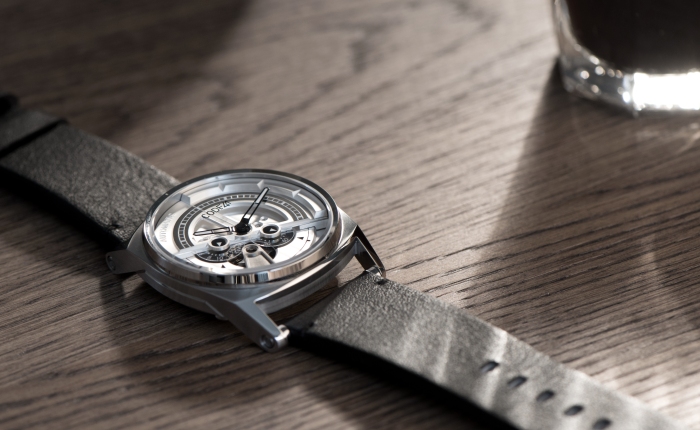CODE41 is a startup initiative that aims to shake up the watch industry with brute transparency

As of current, the Swiss watch industry is all over the place. What we have is a heavily saturated market that’s having to cope with fluctuating currency, weakened overseas demand, criticisms over lack of innovation and trying to adapt to new technology trends. You would think then, that there isn’t room for any new troubles?
It appears that one particular brand isn’t going to let the Swiss watch industry get off lightly. The folks threatening to interfere with the ‘status quo’- Code41, plan to unmask the elements which certain parts of the Swiss watch industry isn’t really keen on sharing.

The emphasis of transparency
Think of the last time you saw a “Swiss Made” written on something. I’m sure you acknowledged it as a mark of precision and high quality associated with some of the world’s most premier brands. That’s pretty fair. You might also think that the product was made entirely in Switzerland. That’s also pretty fair; but there is an off-chance that you could be wrong.
In reality, the use of “Swiss Made” to describe the origin of a product is regulated by the Swiss government. There are two sections in Swiss law which dictate how the term can be used, with one of the laws referencing Swiss watches directly. To save you reading through legislature, the current principle of a Swiss watch is as follows:
- The movement is of Swiss origin
- The movement is cased in Switzerland
- The manufacturer carries out the watch’s final inspection in Switzerland
- A movement is Swiss if at least 50% of its value (not including cost of assembly) was realised in Switzerland AND if it has been assembled and “inspected” by the manufacturer in Switzerland.
- The watch must be fully assembled in Switzerland
There are a few semantics regarding this:
The extent to which a watch is actually “Swiss Made” varies greatly from each individual watch manufacturer. The point of interest (as shown above) is that the component origins of a Swiss Made watch need to be at least 50% to be able to legally use the term. The case, dial and strap can be sourced abroad. I’ll quickly mention that as of 2017, this will be increased to 60%, and will encompass the Case, movement and strap. The movement will still have to be completely “Swiss”
The Code41 project aims to change this with transparency. Run by a trio of designers by a small design studio called Cosanova design. The firm has spent over a decade designing watches for the likes of Tag Heuer, Parmigiani Fleurier and Montblanc. Their concept is being called “TTO”: Total Transparency of Origin. The company will not only let clients know where the watch parts have come from, but also how much they cost to make, and how it differs from the retail price.
I spoke to founder Claudio D’Amore, who explained his approach to the whole thing:
“I always wanted to start a watch brand and at the beginning of this year I thought “why not?”. When we first started, we knew we didn’t want to be like all the other brands in a similar situation. We thought about going the Swiss made route, only to quickly realise what a big joke it was. We didn’t want to be part of that”
Claudio was very vocal about how even the most renowned luxury brands would simply multiply their cost of production up to tenfold. He added however, that the retail for Code41’s watches would be 3.5 times the cost of production (with some subsidies for kickstarter supporters). Claudio explained that the pricing strategy was feasible as the brand would not operate through traditional distributors and retailers. The watches would be available online and then delivered by an eCommerce partner. The company has designed and developed its first model, from the suggestions of up to 10,000 registered users and has raised over 300,000CHF since their campaign launch. The first watches are to be delivered sometime in June
“What we are offering is complete transparency and letting the clients know exactly what they are part of. It’s not like we’ve come up with a brand new concept of horology in terms of movement, we are watch designers who are offering a watch with a great design. Our story is what gets us support from the community”


The watch will feature a Japanese Miyota mechanical movement and will be assembled in China, using Chinese made components. An option of various straps and bracelets will be made available upon order. Pictures with permission from Code41.
My take:
Having looked into the brand and spoken directly to the people behind it, I have to say the prospect at hand is very interesting. Here we have a brand that is willing to share just exactly what goes on behind the scenes of producing their watch.
It has to be said that the idea of letting the clients know price margins of a product can be called “unconventional”. As pointed out, a lot of big labels would rather have it that their customers don’t know the margin between cost of production and final retail. That being noted, the concept of pricing is relative and choosing prices will determine your customers. There will always be a market for people spending exorbitant amounts of money, and luxury brands exist to fill that gap. Customers will always create a mental hierarchy when presented with various price ranges. In the case for Code41, I think this will play as a strength. The brand is unapologetic about it’s use of Chinese components. Such examples of the “no frills” and honest nature, gives the brand a strong sense of integrity. It is the retailer’s job to both set the price and convince the customer. Code41 claim that they can compare quality of production of their piece, with a watch priced at around the $2000-$3000USD mark. That competes with quite a few entry level watch labels. The fact that Code41 will provide all the details of how much their watch actually costs to produce, will most likely lead to heightened buyer confidence. Their Thousands of supporters is a testament to this.
The aforementioned supporters will be crucial in this, as Code41 won’t exactly be making any industry friends with their outspoken views about pricing and origin of components. That being said, the larger Swiss labels won’t really have anything to worry about. Brands that go nearer to the five figure price range are in a different tier entirely; in terms of history, marketing, distribution and quality of production. Code41’s pieces will be competing with entry level watch brands, and so that’s where the pressure will be. The “origin of source” concept is where this pressure will come from. An example that a friend mentioned to me, is that there are a lot of watch startup companies in Asia. Quite a few of them are from common manufacturers in the far East. Some of these brands have been fiddling around with legal loopholes, allowing them to market watches as “Swiss Made”. The watches produced by said brands tend to be made with lower standards than legitimate “Swiss Made” timepieces. The issue is that they then have the nerve to charge a luxury price for them. In other words, newer companies with no track record of success are solely relying on the status that Swiss watch companies have built and earned over the past 300 years.
Personally, I welcome the idea of bringing something fresh to the table. As shown in the dying retail industry of Asia, customers no longer want ‘face on’ value, but are looking for something more “genuine”. There are already labels that cater to this: offering a healthy ratio of quality and price. In terms of horological value, they won’t be turning heads. Their price range roots them at the very entry level of the horology world. What Code41 has however, is a branding concept that’s new. It’s a concept that appeals to many people, which is important. It’s too early however, to say if that will represent any actual value, but I have to give the brand credit for trying. They’ve built themselves up as a sort of ‘Horological political pressure group’ in the watch industry. I absolutely love that. They may not cause the level of disruption they advertised, but they’ll certainly ruffle feathers. By raising awareness, companies might have to reconsider using the term “Swiss Made” on their watches. That’s quite a way to make an entrance into the watch scene. I’m looking quite forward to seeing what they have to offer.
You can check out their campaign here.






